
We often take our veins for granted until something goes wrong. When veins struggle to carry blood efficiently back to the heart, a range of circulatory issues can emerge, collectively known as vein disease. This complex, yet common, medical condition impacts millions across the globe and often goes underdiagnosed, especially in its early stages. At South Florida Multispecialty Hospital, we’re committed to helping our community stay informed and proactive when it comes to vascular health.
Vein disease refers to conditions where the veins become damaged or weak, leading to improper blood flow, particularly from the limbs back to the heart. Because veins rely on one-way valves to keep blood moving in the right direction, any malfunction can cause pooling or even clots. When this happens, patients may experience swelling, visible vein enlargement, skin changes, or pain.
Vein disease comprises several disorders, each with unique symptoms and severity:
Several factors increase a person’s risk for developing vein disease:
While the risk factors may vary, aging consistently contributes to deteriorating vein function.
Vein disease presents a wide symptom spectrum, some subtle and others severe:
Diagnosis typically starts with a physical exam, followed by duplex ultrasound to evaluate blood flow and valve function. In complex or uncertain cases, venography or advanced imaging may be recommended.
For many patients, early-stage vein disease can be managed without surgery. Common conservative therapies include:
These interventions not only alleviate symptoms but may also prevent progression.
When conservative measures aren’t enough, we often recommend minimally invasive or surgical treatments that target the affected veins directly:
These targeted treatments have revolutionized outcomes, treating symptoms and restoring confidence with less invasiveness than ever before.
While genetics may set the stage for vein disease, everyday habits significantly impact vein health. Here’s what we recommend:
Vein disease can impact more than physical comfort, it often disrupts daily routines and overall well-being. We’ve seen patients who stopped enjoying evening walks, couldn’t wear certain clothes due to swollen legs, or lived in constant fear of worsening symptoms.
The good news? With proper diagnosis and proactive care, vein disease is highly manageable. We walk with patients every step of the way from personalized treatment plans to long-term support to ensure they get back to living fully.
Vein disease affects millions but doesn’t have to control your life. From conservative care to advanced treatments, today’s options are effective, minimally invasive, and tailored to individual needs. Whether you’re dealing with visible varicose veins or concerned about leg discomfort, recognizing the signs early and seeking help makes all the difference.
If you’ve been noticing leg swelling, aching, or visible veins, don’t ignore the warning signs. Let our vascular specialists at South Florida Multispecialty Hospital guide your journey to better vein health. Schedule a consultation today—your legs will thank you.
Vein disease refers to conditions where veins can't efficiently return blood to the heart. Common types include varicose veins, chronic venous insufficiency (CVI), deep vein thrombosis (DVT), and venous ulcers.
Factors like genetics, pregnancy, excess weight, and inactivity can weaken vein walls and valves, leading to blood pooling and vein enlargement.
Vein disease is typically diagnosed through physical examination and duplex ultrasound imaging to assess blood flow and valve function. Advanced imaging is used for complex cases.
Symptoms include visible veins, leg heaviness, swelling, throbbing, itching, or cramping, usually worsening after long periods of standing or sitting.
Persistent swelling, pain, discoloration, or visible varicose veins justify medical evaluation, especially if symptoms worsen over time.
Treatment ranges from conservative measures like compression stockings and exercise to minimally invasive procedures like sclerotherapy, EVLT, and surgical vein removal.
Yes, procedures like EVLT and radiofrequency ablation are outpatient-based, highly effective, and pose minimal risk with short recovery times.
Regular movement, weight control, leg elevation, and hydration can significantly reduce symptoms and prevent progression.
Compression garments, elevating legs, anti-inflammatory medication, and laser procedures can relieve discomfort and improve circulation.
Your well-being is our top priority. Reach out today to discover how our dedicated team can support your health journey.
Have questions or want to learn more? Use the form below to get started!
Connect with South Florida’s trusted multispecialty care team and take control of your health with compassion and convenience.
©2025 South Florida Multispecialty Medical Group. All Rights Reserved.